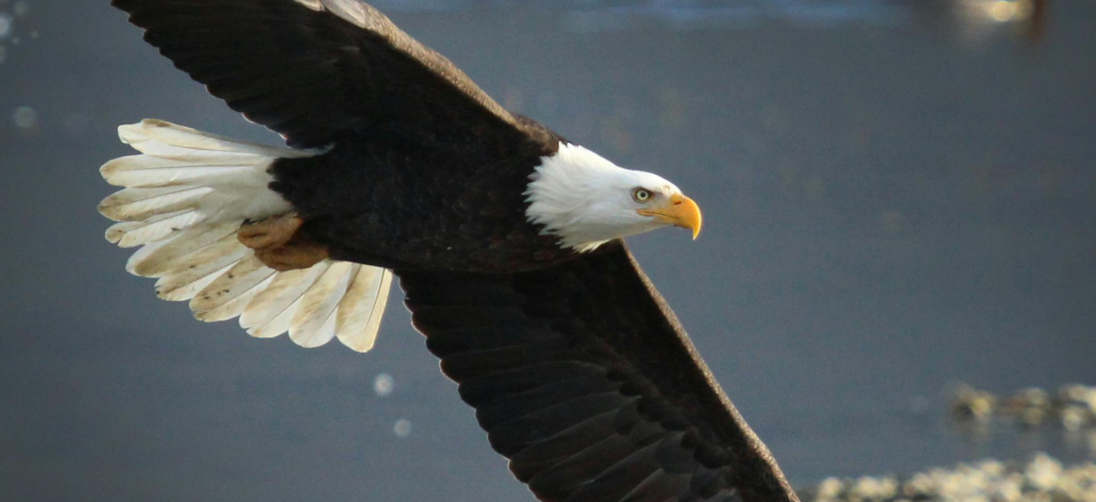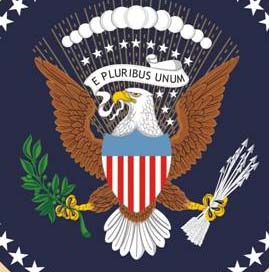
America's Bald Eagles
A remarkable story of success
Advanced level English
Environment and wildlife
 1. When it comes to
wildlife, the
stories that are told in magazines and on television tend to be stories
of
catastrophe and destruction – stories about the disappearance
of species
in the face of ever-more destructive human activity.
1. When it comes to
wildlife, the
stories that are told in magazines and on television tend to be stories
of
catastrophe and destruction – stories about the disappearance
of species
in the face of ever-more destructive human activity.
2. So it comes as nice change to learn that there are exceptions - some of them quite remarkable; and as far as the United States is concerned, there can surely be no more encouraging story than that of the famous "bald eagle", saved at the eleventh hour from the possibility of total extinction in all but the most isolated of regions.
3. For sure, the fact that this magnificent bird of prey is America's national emblem has something to do with it; but for over a hundred years, these great birds' symbolic status did little to save them from destruction.
4. It is estimated that there were in the region of 100,000 bald eagles in the USA in the year 1782, when their image was first adopted as a national emblem by the young States. This great bird, with its wingspan of almost two metres, was almost a natural choice for those who were looking for a symbolic beast to stand alongside the lion of England or the Russian bear. After all, it could be found virtually throughout North America, and was also the only eagle unique to the continent.
 5.
Yet although
they had chosen it
as a proud national emblem, Americans did little to ensure its
survival; in the
course of the nineteenth century and the first half of the twentieth,
the bald
eagle slowly but surely disappeared from state after state, a victim of
spreading urbanization, new farming techniques, and the shotguns of
indiscriminate hunters.
5.
Yet although
they had chosen it
as a proud national emblem, Americans did little to ensure its
survival; in the
course of the nineteenth century and the first half of the twentieth,
the bald
eagle slowly but surely disappeared from state after state, a victim of
spreading urbanization, new farming techniques, and the shotguns of
indiscriminate hunters.
6. In
1940, noting that the national bird was
"threatened with extinction," Congress passed the Bald Eagle
Protection Act,
making it illegal to kill, harass, possess (without a permit), or sell
bald
eagles; but that was not enough to save the bird. By the early
1960s there were fewer than 450
nesting pairs in the contiguous USA;
only in Alaska was their
survival still guaranteed.
7. In 1967, bald
eagles were
officially declared an endangered species throughout the United States
south of
the 40th parallel; and a massive
information campaign was
launched by the federal government and by wildlife organizations, to
try and
save the nation's emblem, and protect its habitat from further
destruction.
8. Among
all factors that had led to the eagle's
destruction, the greatest was almost certainly the massive use of
pesticides by
American farmers, from the 1940's onwards. One such pesticide, DDT, was
sprayed
on croplands throughout the USA
and its residues washed into
lakes and streams, where they were absorbed by fish. The
contaminated
fish, in turn, were consumed by bald eagles.
9. The
chemical interfered with the eagle's
ability to develop strong shells
for its eggs. As a result, bald
eagles and many other bird species began laying eggs with
shells so thin they often broke
during incubation or failed to hatch.
Their
reproduction disrupted, bald eagle populations fell sharply. It was not
until
after the dangers of DDT became known, in large part due to Rachel
Carson's
famous book Silent Spring, that this chemical was
banned for most uses
in the United States in 1972.
10. As the extent
and speed of the
decline in eagle populations became apparent, the U.S. Fish and
Wildlife
Service developed a captive-breeding program at its Research Center at
Patuxent, Maryland. Here scientists increased the species' breeding
potential
by removing each first clutch of
eggs as soon as they were laid,
and incubating them artificially. The bald eagles would usually then
lay a
second clutch, which they were allowed to incubate themselves. In all,
124 bald
eagles were hatched at Patuxent, and subsequently returned to the wild,
during
the critical years.
11. Today, thanks to years of protection and breeding programs, the decline in the eagle population has been reversed, and numbers have begun to grow again. There are now over 4000 breeding pairs south of the 40th parallel, and the bald eagle has been officially taken off the list of endangered species in the USA. Nevertheless, it remains officially classified as a "threatened" species, and one which is protected by no fewer than three acts of Congress - with two other acts banning theft, sale or possession of its eggs.
12. Perhaps that is in the end the only way to ensure the survival of America's most famous bird . Even this high degree of protection is not enough to save the bald eagle from the most ruthless or thoughtless of hunters; there are those who will shoot anything for pleasure.
Not long ago, a Florida man was fined $1500 for shooting an eagle; he got off very lightly, given that federal law allows prison sentences and fines of up to $100,000 for those who knowingly kill or capture these magnificent birds.
WORDS
Discover grammar in a new light
"A breath of fresh air" - IATEFL Voices

Print & ebook from Amazon,
Print book from Barnes & Noble, Waterstones & other good bookshops
Pronunciation:
Note the pronunciation of these words:catastrophe "cat-ass-troffy"
species: " spee-shees "
status : "stay - tus" in British English, "Stat - us" in American English
Copyright notice.
This resource is © copyright Linguapress updated and renewed 2024. Originally published in Spectrum magazine.
This text may not be reproduced on other websites nor in printed form without written permission from the publishers. Reproduction is authorised exclusively for personal use by students, or for use by teachers with their classes.
Student worksheet
►See also: additional IELTS reading practice test for this text.
===============================================================
► Writing exercise - Text contraction.
Reduce each paragraph of this article to no more than 20 words, attempting to keep all the essential information.
► Rephrasing.
What phrases or sentences, used in the original article, mean? You can copy and paste text from the article, or rewrite it in the box, which will expand to take what you write.It was still certain that they would survive
The number of bald eagles decreased very rapidly
How widely and quickly the number of eagles was falling
► Word endings.
Add the necessary word endings, and complete words, to complete this extract from the article. Take care! In four cases, no ending or extra word is needed.
As the ext and speed of the decline eagle populations became apparent, the U.S. Fish and Service developed a captive- program at its Center at Patuxent, Maryland. Here scient increas the spec breed potential by remov each first clutch of eggs as soon as they were l, and incubat them artif The bald eagles w usually then lay a second clutch.
© linguapress.com
Other ideas?
EFL teachers: Help develop this resource by contributing extra teaching materials or exercises.
Click here for further details
This teaching resource is © copyright Linguapress
Revised from a shorter item originally published in Freeway, the Intermediate level English newsmagazine.
Republication on other websites or in print is not authorised



